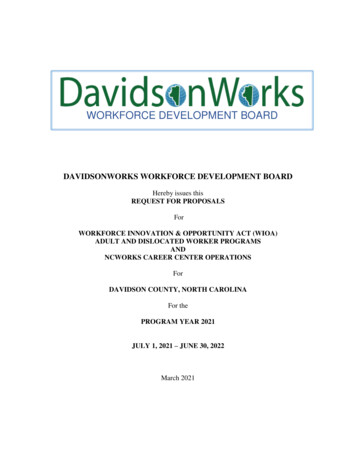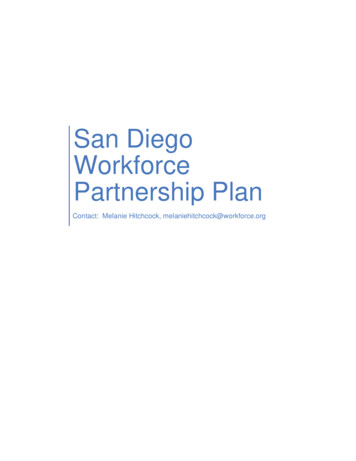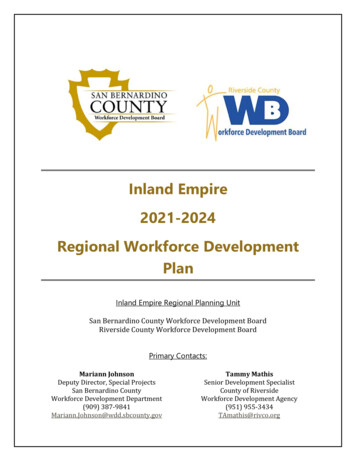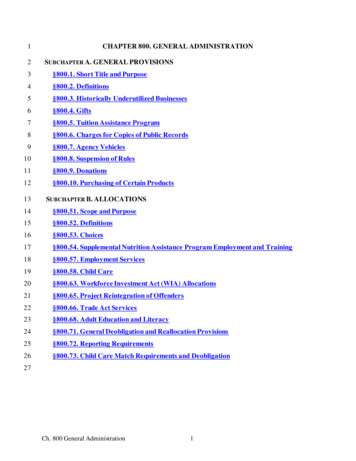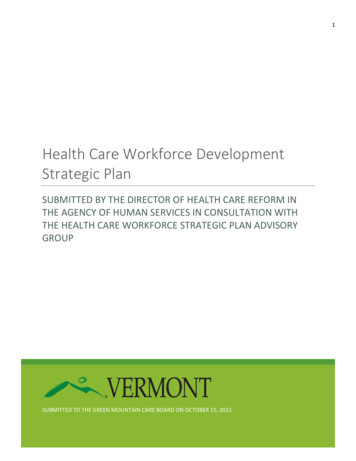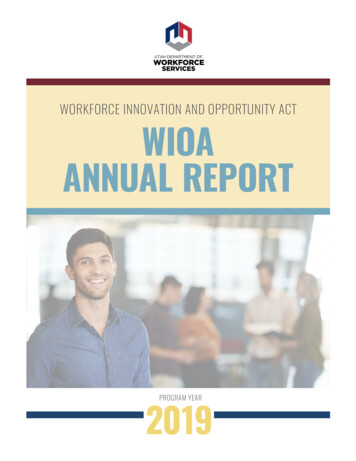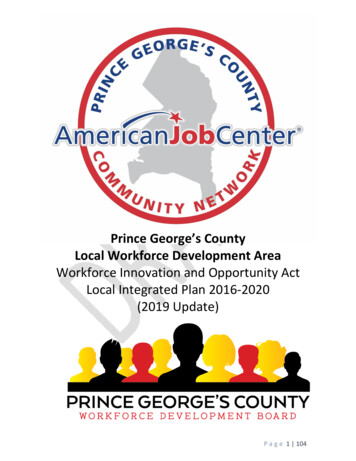
Transcription
Prince George’s CountyLocal Workforce Development AreaWorkforce Innovation and Opportunity ActLocal Integrated Plan 2016-2020(2019 Update)P a g e 1 104
Table of ContentsBackground & Introduction .32019 Systematic Changes .4Acronyms . . .6Section 1: Economic Analysis . .8Section 2: Strategic Planning to Maximize the Earning Capacity ofMarylanders .9Section 3: Strategic Planning to Strengthen the Local Workforce System . .33Section 4: American Job Center Delivery System . .44Section 5: Title I – Adult, Youth, and Dislocated Worker Functions . .56Section 6: Title II – Adult Education and Family Literacy Functions . .64Section 7: Title III – Wagner-Peyser Functions . . . .67Section 8: Title IV – Vocational Rehabilitation Functions .68Section 9: Temporary Assistance for Needy Families Functions . . .70Section 10: American Job Center Delivery System . .73Section 11: Jobs for Veterans State Grants Functions . .74Section 12: Trade Adjustment Assistance for Workers Program Functions .77Section 13: Unemployment Insurance Functions. . .77Section 14: Senior community Service Employment Program Functions . . .78Section 15: Reintegration of Ex-Offenders Functions . .78Section 16: WIOA Section 188 and Equal Opportunity Functions .78Section 17: Fiscal, Performance and Other Functions . .83Executive Signature . 104P a g e 2 104
BackgroundThe Workforce Innovation and Opportunity Act (WIOA) was signed into law on July 22, 2014. WIOAbecame effective July 1, 2015. Full implementation has been mandated to take place on July 1, 2017.WIOA replaces the Workforce Investment Act of 1998 and amends the Adult Education and FamilyLiteracy Act, the Wagner-Peyser Act, and the Rehabilitation Act of 1973.WIOA builds on concepts from past workforce legislation, encourages, and in some respects, requiresfederally funded workforce initiatives to collaborate, co-locate, braid funding and have commonperformance outcomes to serve those looking for employment and businesses who are in need ofqualified job seekers.Section 108 of WIOA requires that each Local Workforce Development Board develop and submit to theGovernor a comprehensive 4-year Local Plan. In accordance with the law, the Prince George’s CountyLocal Workforce Development Board has created a Workforce Innovation and Opportunity Act LocalIntegrated Plan for Prince George’s County.IntroductionThe Prince George’s County Local Workforce Development Board (WDB) is the responsible entity forpolicy development and workforce activities related to administering services and programs funded bythe Workforce Innovation Opportunity Act of 2014. The WDB is the link between job seekers looking tobegin or change careers and businesses looking for skilled workers to maintain their productivity andcompetitiveness in a changing labor market.This plan, updated in 2019, describes the mission, vision, goals and strategies the WDB will implementthrough 2020 to increase the efficiency and effectiveness of the Prince George's County PublicWorkforce System, support the work of the WDB’s partners, and align with the Governors State WIOAPlan. Additionally, this plan outlines the programs and initiatives the WDB has supported and intends toemploy, through competitively procured operators, service providers and partners operating the PrinceGeorge’s County Public Workforce System.Over the next two years the WDB will continue its integrated customer centered design approach to thedelivery of workforce services in Prince George's County. Implementing service delivery strategiestargeted at meeting the individual needs of our job seekers and businesses will increase the economicvitality of the economy by providing the County with residents who are financially self-sufficient, highlyskilled and possess the essential skills required to be productive in an international market. An increasein the quality of the Prince George’s County labor force will lead to an increase in the productivity andcompetitiveness of our local economy encouraging existing businesses to remain in Prince George'sCounty and invite businesses outside of the County to relocate. The success of our customer centereddesign approach of workforce services under the Workforce Innovation Opportunity Act is contingent onthe WDB strengthening its relationship with Prince George’s County Government, consistentlyintegrating and improving its relationship with existing and mandatory partners and the development ofits relationships with various community stake holders in Prince George's County.P a g e 3 104
This Prince George's County WIOA Local Integrated Plan Update explains the current operations ofPrince George's County and provides an overview of the future operational structure of the PrinceGeorge’s County Workforce System through 2020.Systematic ChangesThe WDB fully adopted the American Job Center branding in 2018. Included in this rebranding wasrenaming the Prince George’s County Public Workforce System the Prince George’s County AmericanJob Center Community Network. Additional branding included renaming the Prince George’s Countycomprehensive job center, the Prince George’s One Stop, to the American Job Center Largo, and namingthe local workforce development area’s future job centers in National Harbor as the American JobCenter National Harbor, and naming the American Job Center located at the Prince George’s CountyRegional Workforce Hub as American Job Center Temple Hills.The WDB made these changes to create brand recognition that aligned with the State of Maryland, theMaryland Department of Labor, Licensing and Regulation, the United States Department of Labor, WIOApartners and grantees, military installations, unemployment insurance, and other partners of thenational American Job Center Network. The WDB believes that brand recognition aligned with the Stateof Maryland and the American Job Center Network will decrease confusion and increase traffic flow tothe AJCCN and American Job Center Largo.P a g e 4 104
Along with fully rebranding the Prince George’s County Public Workforce System the Prince George’sCounty American Job Center Community Network (AJCCN), the WDB added a membership componentto the AJCCN. Membership is identified in three tiers: Service Provider / Affiliated Site – WIOA Mandated Partners, Local Mandated Partners, WDBCompetitively Procured Service Providers, WDB non-WIOA funded Sub-grantees, and partnerswith fiscal relationships with the WDB Local Access Point – Partners providing workforce development services or access to workforcedevelopment services to Prince George’s County residents, at no cost to the resident General Member – Partners who would like access to AJCC programming and notifications, butdon’t provide workforce development services or access to workforce development servicesAlong with rebranding the Prince George’s County Public Workforce System in 2018, the WDB changedits fiscal agent, staffing contractor and WIOA Title I provider from the Prince George’s County EconomicDevelopment Corporation to Employ PrinceGeorge’s Incorporated (EPG). This change wasdue to the Prince George’s County EconomicDevelopment Corporation-Workforce ServicesDivision separating from the Prince George’sCounty Economic Development Corporation tobecome EPG. EPG is a 501c3 nonprofitorganization based in Largo, Maryland. EPGstaffing and programming was transitioned fromthe Workforce Services Division, and theyadminister a menu of workforce development services for job seekers and businesses. The goal of EPGis to improve the local Prince George’s County economy by creating a demand driven system thatdelivers qualified workers to businesses and provides job seekers with opportunities for careers in highdemand/high growth industries. The WDB, Prince George’s County Executive, and EPG solidified thisnew partnership by executing a Prince George’s County Local Workforce Development Area LocalGovernance Agreement in July of 2018. The WDB and EPG executed an additional agreement, thePrince George’s County Local Workforce Development Board Local Operation Agreement, in Decemberof 2018 to further clarify the roles of each entity in the Prince George’s County Local WorkforceDevelopment Area. Both agreements have four-year terms with renewal options.As referenced above, the last major change from the publishing of the initial 2016-2020, is the WDB’sapproval to expand access across Prince George’s County. The WDB approved opening two AmericanJob Centers through 2020. The first American Job Center will open in 2019 at National Harbor and benamed American Job Center National Harbor. The second American Job Center will open in 2020 at thePrince George’s County Regional Workforce Hub and be named American Job Center Temple Hills. TheWDB believes that these locations will increase access to job seekers and communities that areunderserved and experiencing barriers to employment, and that these locations will lead to increases inthe number of job seekers and businesses served by the Prince George’s County Public WorkforceSystem.P a g e 5 104
Acronym ListTable 1 YPPGCCPGCPSMeaningAmerican with Disabilities ActAdult Education and Family Literacy ActPrince George’s County American Job Center Community NetworkBusiness ConsultantCapital Area Health Care AllianceComprehensive Adult Student Assessment SystemsCareer Consultant of the DayPrince George’s County One Stop Career Center NetworkCustomized Job TrainingChief Local Elected OfficialCustomer Relationship Management SystemCareer Services SpecialistPrince George’s County Construction Works ProgramPrince George’s County Department of Family ServicesMaryland Department of Labor, Licensing and RegulationsDepartment of LaborMaryland Department of Rehabilitation ServicesMaryland Department of Social ServicesDisabled Veterans Outreach ProgramPrince George’s County Economic Development CorporationEmploy Prince George’s, Inc.Prince George’s County Educational Partnership for IT CareersEqual OpportunityGeneral Equivalency DiplomaGovernors Workforce Investment BoardPrince George’s County Hospitality & Accommodation InstituteHigh School DiplomaPrince George’s County Industry Bridge ProgramIndividual Employment PlanIndividual Services AccountIndividual Service StrategiesIndividual Training AccountKnowledge Equals Youth SuccessLocal Elected OfficialLocal Veterans Employment RepresentativeMemorandum of UnderstandingMaryland Workforce ExchangePrince George’s County Office of Central ServicesOn the Job TrainingOffice of Youth ProgramsPrince George's Community CollegePrince George's County Public SchoolsP a g e 6 104
POSRSASBESEWDPSOPTABETANFUCAPWDBWIAWIOAWSDPriority of ServiceResource Sharing AgreementsSignificant Barriers to EmploymentPrince George’s County Sustainable Energy Workforce Development ProgramStandard Operating ProcedureTest of Adult Basic EducationTemporary Assistance for Needy FamiliesPrince George’s County United Community Action PartnershipPrince George's County Workforce Development BoardWorkforce Investment ActWorkforce Innovation ActPrince George’s County Economic Development Corporation-Workforce Services DivisionP a g e 7 104
Section 1 – Economic AnalysisPrince George’s County is a diverse, high-value, and continually expanding county with an equallydiverse economy. Unique in location, Prince George’s County borders the nation’s capital, Washington,D.C., and is home to numerous federal agencies including the Internal Revenue Service, Census Bureau,NASA Goddard and Joint Base Andrews. Prince George’s County also borders Alexandria, Virginia andseveral large counties in Maryland: Montgomery, Anne Arundel and Howard. The County’ssurroundings have given way to a well-developed transportation and mass transit network in themetropolitan areas and express access to two major transit hubs: Ronald Reagan Washington NationalAirport and Union Station.Prince George’s County is equally an in-demand region due to its affordability and access to qualityeducational institutions. Compared to its surrounding local metropolitan areas, Prince George’s Countyhas an extremely competitive real estate market and strong higher education base. The County is hometo the University of Maryland, Bowie State University, Prince George’s Community College, CapitalTechnology University and University of Maryland University College.Forming a southern border between Prince George’s County and Washington, D.C. is the Potomac River.Considered a geographical gift to Prince George’s County, the Potomac River is the home of PrinceGeorge’s County’s National Harbor. National Harbor is a mixed-use waterfront development that ishome to MGM National Harbor Resort, Gaylord National Resort & Convention Center, Tanger Outletsand a host of restaurants, hotels, retail shops, apartments and businesses. Once fully developed, theNational Harbor area is estimated to host over 15,000 employment opportunities. The National Harboremployment opportunities will greatly increase the existing supply of accommodation/hospitality, retailand food services industry employment opportunities.Along with the development of National Harbor, Prince George’s County is home to a growing retailindustry that has been sparked by the development of Ritchie Station Marketplace and the addition ofWoodmore Town Center, a 245 acre mixed-use development that includes Wegmans, Costco, Best Buy,Men’s Warehouse, and Nordstrom Rack. Prince George’s County will also be the home to a newUniversity of Maryland Regional Medical Center, the Purple Line (16 mile light rail connectingMontgomery County and Prince George’s County), and a state-of-the-art Kaiser Permanente MedicalCenter. The additions above will be great compliments to National Harbor’s newest entertainmentattraction opening in 2019, Topgolf National Harbor.The economic drivers listed above are defining characteristics in the County’s demanding and everchanging labor market. Additionally, Prince George’s County is home to large rural areas where thereexists a lack of transportation options resulting in an unemployment rate exceeding that of the State ofMaryland. The goal of the WDB is to meet the needs of all stakeholders and demographics within PrinceGeorge’s County.P a g e 8 104
Section 2 – Strategic Planning to Maximize theEarning Capacity of Marylanders(A) An analysis of the knowledge and skills needed to meet the needs of the businesses in the LocalArea, including employment needs in in-demand industry sectors and occupations.Prince George’s County’s educational attainment is below the national average in two key areas,Bachelor’s and Associate’s Degrees. 17.4% of Prince George’s County residents possess a Bachelor’sDegrees, 1.2% below the national average. Likewise, 5.9% of Prince George’s County residents possessan Associate’s Degree, 2.1% below the national average. The amount of Prince George’s Countyresidents with a graduate degree or higher is 13.2%, which is 1.6% higher than the national average.Overall Prince George’s County has a large percentage of residents who have received post-secondarytraining, a bachelor’s degree or higher, 58.8%. This is a positive attribute for the County, and the WDBbelieves it increases Prince George’s County’s attractiveness to local businesses.Table 1.1 Prince George’s County Educational AttainmentSource: EMSI 2019.1; ACSPrince George’s County’s large percentage of residents with post-secondary training, a bachelor’sdegree or higher translates to the educational attainment of Prince George’s County job seekers. Overall49% of Prince George’s County job seekers in the Maryland Workforce Exchange’s (MWE) hold anAssociate’s Degree, Bachelor’s Degree, or higher.P a g e 9 104
Table 1.2 Prince George’s County Job Seekers Education LevelEducation Level of Available CandidatesRankMinimum Education LevelPotential CandidatesPercent0N/A2411.10%5,51325.23%1No Minimum Education Requirement2Less than High School3High School Diploma or Equivalent41 Year of College or a Technical or Vocational School0N/A52 Years of College or a Technical or Vocational School0N/A63 Years of College or a Technical or Vocational School0N/A7Some College10.01%8Vocational School Certificate2,0209.24%9Associate's Degree1,8978.68%10Bachelor's Degree5,42924.84%11Master's Degree2,72212.46%12Doctorate Degree5062.32%13Specialized Degree (e.g. MD, DDS)1490.6814Not Specified0N/ASource: Maryland Workforce Exchange – Prince George’s County Job Seeker Education LevelWhen comparing the educational attainment of Prince George’s County job seekers to the educationalrequirements of Prince George’s County job openings the comparison is favorable, please see Table 1.9below. Based on the available data, Prince George’s County job seekers with an Associate’s Degree orhigher exceeds the job openings requiring an Associate’s Degree or higher. Likewise, Prince George’sCounty’s supply of job seekers with less than an Associate’s degree exceeds the demand of positions byemployers requiring an Associate’s degree or less.Table 1.3 Prince George’s County Education Level of Jobs & CandidatesEducation Level of Jobs & CandidatesEducation LevelJob OpeningsPercentage of JobOpeningsPotentialCandidatesPercentage ofPotential CandidatesNo Minimum EducationRequirement4353.53%0N/A0N/A2411.10%High School Diploma orEquivalent9407.62%5,51325.23%1 Year of College or aTechnical or VocationalSchool120.10%0N/ALess than High SchoolP a g e 10 104
2 Years of College or aTechnical or VocationalSchool40.03%0N/A3 Years of College or aTechnical or VocationalSchool110.09%0N/A0N/A10.01%Vocational SchoolCertificate180.15%2,0209.24%Associate's Degree1321.07%1,8978.68%Bachelor's Degree8336.75%5,42924.84%Master's Degree560.45%2,72212.46%Doctorate me CollegeSpecialized Degree (e.g.MD, DDS)Not SpecifiedSource: Maryland Workforce Exchange – Prince George’s County Education Level of Jobs & CandidatesThe Maryland Workforce Exchange has a large percentage of jobs that are listed as “Not Specified” inrelation to education level. This skews the Maryland Workforce Exchange data, but EMSI data related tounderemployment provides a more defined view of the education requirements of jobs compared tothe educational attainment of Prince George’s County residents.EMSI’s underemployment data compares the minimum education attainment requirement for jobsposted in Prince George’s County with the educational attainment of Prince George’s County residents.Similar to the Maryland Workforce Exchange data, EMSI data shows that Prince George’s Countyresidents with some college, an Associate’s Degree, Bachelor’s Degree or higher exceed the amount ofjobs that require some college, an Associate’s Degree, Bachelor’s Degree or higher. EMSI data provides amore conclusive perspective for jobs with lower educational attainment requirements. EMSI data showsthat Prince George’s County falters on the having an adequate amount of residents with no formaleducation or a high school diploma compared to the amount of jobs available requiring a high schooldiploma or less.P a g e 11 104
Table 1.4 Prince George’s County UnderemploymentSource: EMSI 2019.1; QCEW & non-QCEWAlthough the data shows that Prince George’s County residents don’t have an adequate number ofresidents with formal education or a high school diploma compared to the amount of jobs availablerequiring a high school diploma or less, the County does have a large percentage of residents with somecollege, an Associate’s Degree, Bachelor’s Degree or higher. As stated previously, 58.8% of PrinceGeorge’s County residents have received post-secondary training (some college), a Bachelor’s Degree orhigher. Based on these data sets it could be assumed that a large number of Prince George’s Countyresidents are underemployed and working jobs that are beneath their education and skill levels. This isincorrect, due to the total population residing in Prince George’s County and the commuting patterns ofPrince George’s County residents. Below is an overview of population and labor force data for PrinceGeorge’s County. Data related to commuting patterns will follow.According to the American Community Survey, Prince George’s County was home to 919,849 residentsin 2018, with an estimation of over 920,000 in 2019. The 2018 Prince George’s County population wasan increase of more than 3.1%, or27,885, from 2013. The population growth of Prince George’s Countyis consistent with the state of Maryland and the nation.P a g e 12 104
(B) An analysis of the workforce in the Local Area, including current labor force employment (andunemployment) data, and information on labor market trends, and the educational and skill levels of theworkforce in the Local Area, including individuals with barriers to employment.Since the Great Recession began in 2007, the United States has experienced an economic roller coasterof ups and downs that adversely effected local economies, including Prince George’s County. However,Prince George’s County’s decline began before the Great Recession. The Prince George’s CountyEconomic Catalyst Report of 2013, prepared by Battelle Technology Partnership Practice, Jacob FranceInstitute at the University of Baltimore and Green Doors Advisors stated,“During the past decade, before the Baker Administration and the new County Council tookoffice, Prince George s County lost ground in economic development, even as the broaderWashington, D.C.-Baltimore region, in which it is centrally-located, made impressive gains. From2001 to 2011, Prince George s County lost nearly 5,400 jobs, or 1.8 percent of total employmentin the county.”The report goes on to say that both the Great Recession and a loss of regional competitivenesscontributed to a faltering Prince George’s County economy. The faltering economy nationally andlocally culminated in an erosion of the job market that stunted job growth and enhanced job loss.Prince George’s County reached its highest unemployment rate of 7.9 % in 2011. The 2019 PrinceGeorge’s County State of the Workforce Report, produced by EMSI on behalf of the WDB, reports thatthe County lost over 264 (net) businesses during the recession. As of October 2018, Prince George’sCounty had an October 2018 unemployment rate of 4.04%, decreasing from 6.91% 5 years before (seetable below).Table 1.5 Prince George’s County Unemployment Rates 2013 – October 2018Source: EMSI 2019.1; LAUSWith the Great Recession ending in 2009, policies enacted by the 44th President Barack Obama,Congress, Prince George’s County Council, and Prince George’s County Executive Rushern L. Baker in2008 – 2010, respectively improved local economic conditions and the Prince George’s County economyP a g e 13 104
began to rise. From 2012 to 2017, Prince George’s County added 317 new businesses. This increasegained back the County’s businesses lost during the recession along with 50 more.Today Prince George’s County is amidst a multibillion dollar economic boom producing promisingeconomic trends of a growing population, labor force, and consistently increasing employmentparticipation rates. As of December 2018, Prince George’s County had a population of 919,849, anincrease of 27,885 over the last 5 years, and a projected growth rate of 20,280 over the next 5 years.Prince George’s County boast a labor force of 509,688, an increase in jobs of 6.7% over the past fiveyears, and a labor force participation rate increasing from 67.3% to 68.1% over the past five years.Compare this the statistic presented in our original local plan of a labor force of 493,774 in April of 2016.Coinciding with Prince George’s County’s increasing labor force and labor force participation rates, theunemployment rate has continuously declined. Since 2011 the Prince George’s County unemploymentrate has decreased from 7.9% to lows of 3.7% in 2018. The Maryland and Prince George’s Countyeconomies have consistently experienced lower unemployment rates than the US. Prince George’sCounty’s increases in labor force and employment, and its continuous decreases in unemployment, canbe attributed to many sources, but what’s evident is the past and future growth projections of severalmajor industries that are driving the County’s success.Prince George’s County’s unique geographical location makes it extremely attractive to businessesaround the world. Based on data from DLLR, the top three projected growth industries within PrinceGeorge’s County are Transportation and Warehousing, Retail Trade and Health Care and SocialAssistance. When reviewing the growth and in-demand industries from a regional lens the PrinceGeorge’s County Economic Catalyst Report of 2013, stated that Prince George’s County’s growingindustries also include the Federal Government and Information Technology.Based on the labor market information provided by the Bureau of Labor and Statistics, MarylandDepartment of Labor, Licensing, and Regulations and the Prince George’s County State of the WorkforceReport, the Prince George’s County Workforce Development Board has identified the followingindustries as the primary in-demand industries of focus for the Prince George’s County Public thcare and Social ServicesFood and Beverage ManufacturingAdvanced ManufacturingConstruction and Real EstateProfessional, Scientific, and Technical ServicesEducationTransportation and LogisticsGovernment ServicesInformation TechnologyBusiness ServicesRecreation, Tourism and HospitalityEnergy & UtilitiesRetailP a g e 14 104
These industries were chosen based on their contribution to the Prince George’s County GRP,employment, location quotient, projected growth within Prince George’s County. The Prince George’sCounty State of the Workforce Report didn’t include the Energy & Utilities Industry, nor did it includethe Retail Industry as being a Prince George’s County in-demand industries. The WDB included Energy &Utilities and the Retail Industry as in-demand due tomultiple factors.As seen in Table 1.1 below, the Retail Industry is one of thetop three industries in Prince George’s County with themost advertised job openings on the Maryland WorkforceExchange. The WDB predicts that the vast amount of jobopenings in the Retail Industry will continue based on thePrince George’s County Government’s efforts to increasePrince George’s County’s as a tourist attraction/destinationand increase the quality of life for residents who want an abundance of retail options and high-end retailoptions. Area’s such as National Harbor, featuring Tanger Outlets, and Woodmore Town Centre,featuring Nordstrom Rack, are examples of the retail development efforts in Prince George’s County.Table 1.6 Industries by Advertised Jobs TableRankIndustryJob Openings1Professional, Scientific, and Technical Services1,9602Health Care and Social Assistance1,2273Retail Trade1,0834Accommodation and Food Services9925Administrative and Support and Waste Management and Remediation Services6526Educational Services5317Manufacturing3988Public Administration2609Construction243P a g e 15 104
10Wholesale Trade196Source: Maryland Workforce Exchange - Online advertised jobs dataThe WDB added the Energy & Utilities Industry due to the multiple utility mergers, Alta Gas and Exelon,creating increases in employment opportunities and business development opportunities for Countybusinesses. Additionally the WDB added the Energy & Utilities Industry to the County’s in-demandindustry list based on the Prince George’s County Government’s efforts to grow the manufacturing,installation and production of sustainable energy in Prince George’s County. Led by the Prince George’sCounty Office of Central Services (OCS), and their Sustainable Energy Department, OCS has an objectiveof providing reliable and environmentally sound energy solutions that enhance the quality of life ofPrince George's County residents while consistently maximizing energy savings for County residents. TheOCS Sustainable Energy Department coordinates the County’s efforts to reduce their energy 3 C's:1. Reduce energy CONSUMPTION,2. Reduce energy COST, and3. Reduce County-wide CARBON EMISSIONS.Along with reducing the County’s energy 3 c’s, OCS is leading the County’s efforts to build capacity in thePrince George’s County Energy Sector. Building the capacity of the sector has led to, and will continueto lead to, economic development and job creation in Prince George’s County.The WDB has partnered with OCS to increase the amount of Prince George’s County resident trainedand employed in sustainable energy and traditional utilities. An additional justification for the WDBadding the Energy & Utilities Industry to the County’s in-demand industries list is the wages andearnings residents can receive while being employed in the Energy & Utilities Industry. The Energy &Utilities Industry provides the highest earnings for Prince George’s residents.P a g e 16 104
Table 1.7 Prince George’s County Earnings per WorkerSource: EMSI 2019.1; LPIThe County’s focus and investment in the Energy & UtilitiesIndustry has led to funds for sustainable energy workforce andeconomic development programs, and the launch of the PrinceGeorge’s County Sustainable Energy Workforce DevelopmentProgram.The WDB will be working with a graphic designer to createinfographics, flyers and an official Prince George’s CountyState of the Workforce Report fo
onsidered a geographical gift to Prince Georges ounty, the Potomac River is the home of Prince Georges ou nty [s National Harbor. National Harbor is a mixed-use waterfront development that is home to MGM National Harbor Resort, Gaylord National Resort & Convention Center, Tanger Outlets
